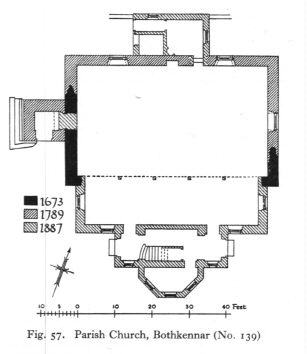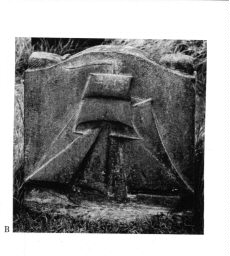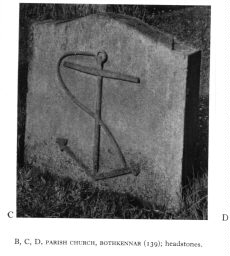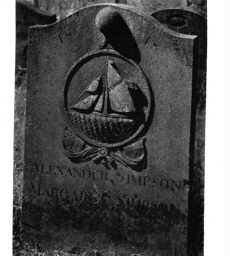
The internal arrangements of the church date only from the reconstruction of 1887. The pulpit now stands in front of a recess in the centre of the N. wall, and E. of it a door has been broken through into the vestry.
139. Parish Church, Bothkennar.
Bothkennar, now a quoad sacra parish under Grangemouth, was formerly independent, and its church stands in a graveyard N. of the by-road leading from the Polmont-Stirling highway (A 905), at Pinfoldbridge, to Carronshore The church (Fig. 57) was "rebuilt" in 1789 and remodelled and enlarged in 1887, when an extension containing new entrances was added on the S. and a vestry on the N.; the work of 1789 is no doubt commemorated by a stone bearing that date which is built into the wall, high up, near the NE. corner. It is clear, however, that this rebuilding was not total, and that remains of an older structure survive; evidence for this is seen in the masonry of the lowermost four feet or so of the walls, as under each of the existing windows on the N. side, which have been placed to suit a higher floor than that of the older structure, there appear the lower rybats and sill of an original window, now built up, with dressed and backset margins. Similarly, the bottom part of an original door way survives under the window in the E. gable, while a corresponding doorway, now also built up, in the centre of the opposite gable provided the access to the church until the new entrances were formed in 1887. The structure to which these openings belonged, and the lower courses of masonry in which they are found, may perhaps have originated in 1673, as this date is incised high up on the W. gable near the SW. corner; this inscription also suggests the retention at the southern ends of the gables of some of the higher parts of the walling of this period, as well as of the lower, during the rebuilding in 1789.
Though the difference between old and new work is hardly
perceptible in the face of the E. gable, there is a decided contrast between
the character of the masonry in the southern and northern halves of the
W. gable, and this tends to confirm the idea that earlier work was retained
on the S.; it may also be significant that the southern angles of the church
have slightly backset dressed margins, similar to the old doors and windows,
in contrast with the plain quoins of the angles on the N. Apparently the
size of the church remained unchanged until the 19th-century reconstruction,
when most of its southern wall was removed to allow for increased accommodation
in the new additions on that side. The original church, rectangular on
plan, measured 57 ft. 9 in. by 35 ft. externally, the walls being 2ft.
9 in. thick and built of random rubble. The present windows are round-headed
and have rounded arrises.
 |
Abutting on the W. gable is a tower, erected either during
the alterations of 1789 or very shortly afterwards. On plan it is
1 1 ft. square over walls approximately 3 ft. thick; it rises to a height
of four storeys, the upper ones being reached by ladders and hatchways.
A door in the middle of its S. wall leads into a small chamber 5 ft. square,
which served as a vestibule before the W. door was built up. The top storey
is used as a belfry. In its ascent the tower is intaken at two stages,
the lower between the first and second storeys, at about the level of the
eaves of the church, and the higher between the upper two floors. Below
the lower intake the masonry is squared rubble roughly brought to courses,
but higher up it is ashlar to the apex of a concave-sided pyramidal roof.
This alteration may indicate a delay in the completion of the upper portion.
The openings on the second floor are lintelled but elsewhere they are round-headed.
The church bell dates only from 1911. An earlier bell, by Robert
Maxwell & Co., Edinburgh, has been removed to Fallin; it is dated 1729
and is similar in design and lettering to the Meikle bell at Gargunnock.
The internal arrangements of the church date only from the reconstruction of 1887. The pulpit now stands in front of a recess in the centre of the N. wall, and E. of it a door has been broken through into the vestry. |
TOMBSTONES. The only tombstone in the churchyard
on which a date earlier than 1707 can be made out is a small headstone
inscribed in relief 1640 / 1 A. Some of the later stones (P1. 48
B, C, D) show fine representations of ships, and no doubt commemorate
seamen of the former port of Carronshore
 |
 |
 |
903834 NS 98 SW ("Church") 23 March 1953
309. The Manse, Bothkennar.
The manse of Bothkennar, which stands 8o yds. NW. of the parish church (No. 139), was built in 18161 and, apart from some internal alterations, provides a good sample of the domestic building of its time. It is a substantially built house of two storeys and an attic, measuring 51 ft. 9 in. by 35 ft. 3 in. and facing SSE. The walls are of rubble, and rise above a plain plinth to a Classical cornice at eaves-level with a blocking-course having a raised central portion. The gables are tabled and are crossed at eaves- level by a plain band; voids and quoms have narrow backset margins and the roof is slated. The S. side contains a central door and five windows symmetrically spaced; those flanking the door have three lights and a segmental head while the first-floor ones are lintelled. The attics are lit by dormers at the back. The W. gable is blank, but the E. one has two windows on each floor, the SE. ones in each case being dummies. The front door is framed by two sunk, moulded pilasters carrying an entablature, and has a fanlight. It leads to a hall from which a drawing-room and a dining-room open respectively to right and left, while at the inner end a stone wheel-stair, lit by a N. window, rises to the bed rooms above. The stair has a mahogany handrail and iron balusters, alternately plain and wrought. Contemporary with the house, and reached by a back door, is a small courtyard, enclosed on N. and E. by a one-storeyed, flat- roofed building which comprises offices and out-houses.
902835 NS 98 SW 24 March 1953